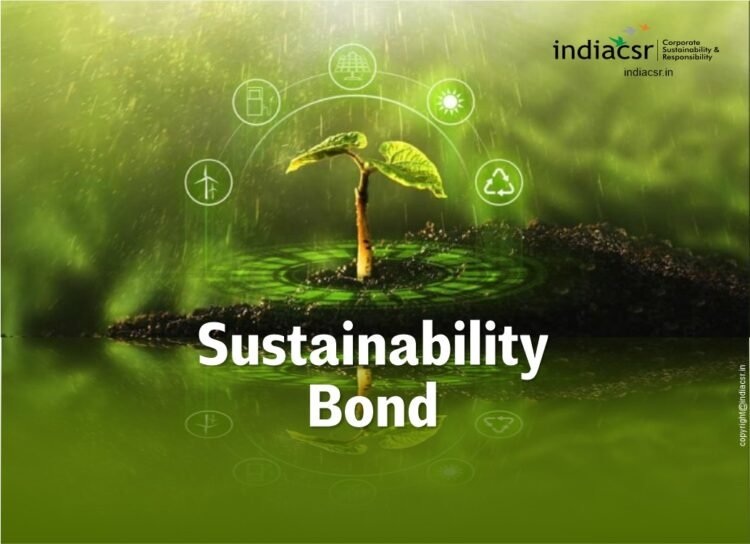A sustainability bond is a type of debt instrument issued by companies, governments, or other entities to finance projects that have positive environmental and social impacts. These bonds are part of the broader sustainable finance market, which includes green bonds and social bonds. Sustainability bonds are a powerful financial tool that bridges the gap between profit and purpose. These fixed-income instruments play a crucial role in funding projects that benefit both the environment and society.
Purpose of Sustainability Bonds
The primary purpose of sustainability bonds is to raise capital for projects that contribute to environmental sustainability and social development. These projects typically align with specific goals, such as reducing carbon emissions, promoting renewable energy, improving water and waste management, supporting affordable housing, and enhancing social services.
What Are Sustainability Bonds?
Sustainability bonds are a subset of green bonds, but with a broader scope. Here’s what makes them unique:
Purpose: The proceeds from sustainability bonds are exclusively used to finance or refinance a combination of green and social projects. These projects align with the four core components of the International Capital Market Association (ICMA) Green Bonds Principles and Social Bonds principles1.
Green and Social Categories: Unlike green bonds (which focus solely on environmental projects) and social bonds (which address social issues), sustainability bonds combine both. They support initiatives that promote environmental sustainability and social well-being.
Key Features of Sustainability Bonds
- Dual Focus: Sustainability bonds fund both environmental and social projects, unlike green bonds (which focus solely on environmental benefits) or social bonds (which focus solely on social benefits).
- Use of Proceeds: The funds raised from sustainability bonds are earmarked for specific projects that meet predefined criteria for environmental and social impact. These criteria are usually aligned with international standards, such as the International Capital Market Association (ICMA) Sustainability Bond Guidelines.
- Transparency and Reporting: Issuers of sustainability bonds are typically required to provide detailed reports on the allocation of proceeds and the impact of funded projects. This transparency helps ensure that the funds are used as intended and allows investors to track the benefits generated by their investments.
- Investor Appeal: Sustainability bonds attract a broad range of investors, including those who are specifically interested in responsible and sustainable investing. These investors are often looking for opportunities to support projects that generate positive societal outcomes while earning a financial return.
- Certification and Verification: Many sustainability bonds are certified or verified by third-party organizations to ensure that they meet specific sustainability criteria. This certification process adds credibility and reassures investors about the authenticity of the bond’s sustainability claims.
Core Components of Sustainability Bonds
Let’s break down the essential elements of sustainability bonds:
Use of Proceeds:
- Identify specific green and social categories or projects to be financed.
- Examples of green project categories include energy, buildings, transport, water management, waste control, and nature-based assets.
- Social project categories encompass affordable housing, employment, food security, and socioeconomic advancement.
Project Evaluation and Selection
Define the process for evaluating eligible projects using issuer-specific criteria.
Rigorous evaluation ensures that funded projects genuinely contribute to sustainability goals.
Management of Proceeds
Establish a transparent process for tracking, allocating, and spending bond proceeds.
Accountability ensures funds are directed toward impactful projects.
Reporting
Issuers must disclose relevant information to investors.
Transparency builds trust and allows stakeholders to monitor progress.
Challenges and Controversies
While sustainability bonds hold immense promise, challenges persist:
Greenwashing Risk
- Some worry that not all bond revenues are systematically applied to genuinely positive environmental outcomes.
- Clear definitions and rigorous monitoring are essential to prevent greenwashing.
Profit vs. Purpose
- Balancing financial returns with sustainability objectives remains a delicate dance.
- Businesses must prioritize impact over mere label branding.
Examples of Projects Funded by Sustainability Bonds
- Environmental Projects: Renewable energy installations (solar, wind, hydro), energy efficiency upgrades, pollution prevention and control, sustainable water and wastewater management.
- Social Projects: Affordable housing, healthcare facilities, educational programs, microfinance initiatives, projects that support marginalized communities.
Benefits of Issuing Sustainability Bonds
- Diversification of Funding Sources: Issuing sustainability bonds allows companies and governments to access a broader pool of investors, including those with a focus on sustainable investing.
- Enhanced Corporate Reputation: By issuing sustainability bonds, entities can demonstrate their commitment to sustainability and social responsibility, which can enhance their reputation and brand value.
- Positive Impact: Sustainability bonds provide tangible benefits to society and the environment, contributing to the achievement of global sustainability goals such as the United Nations Sustainable Development Goals (SDGs).
*****
Beyond Sustainability Bonds: Sustainability-Linked Bonds (SLBs)
Sustainability-Linked Bonds bridge the gap between financial markets and sustainability goals. As investors increasingly prioritize ESG factors, SLBs offer a dynamic pathway to responsible finance, encouraging positive change while ensuring financial returns. A new category, sustainability-linked bonds (SLBs), addresses these concerns. SLBs tie financial characteristics to predefined sustainability objectives. If issuers fail to meet targets, they face penalties in the form of higher coupon rates.
Sustainability-Linked Bonds (SLBs) are fixed-income instruments where the financial or structural characteristics are directly linked to predefined sustainability or Environmental, Social, and Governance (ESG) objectives1. Unlike green bonds, which fund specific environmentally beneficial projects, SLBs allow issuers to use the proceeds for general corporate purposes. However, there’s a catch: the issuer commits to achieving specific sustainability goals within a defined timeframe.
Sustainability-Linked Bonds (SLBs): A Path to Responsible Finance
Let’s delve into what SLBs are, how they work, and their implications for responsible investing.
In the ever-evolving landscape of sustainable finance, Sustainability-Linked Bonds (SLBs) have emerged as a powerful tool. These innovative bonds go beyond the traditional “use of proceeds” model and tie financial terms to specific sustainability targets.
Key Components of SLBs
- Key Performance Indicators (KPIs): Issuers select relevant KPIs that align with their overall business strategy. These KPIs must be measurable, externally verifiable, and beyond business-as-usual targets.
- Sustainability Performance Targets (SPTs): SPTs represent material improvements in the chosen KPIs. They are set before or concurrently with bond issuance and evaluated periodically.
- Bond Characteristics: SLBs adjust financial or structural features (such as coupon rates) based on the issuer’s performance against SPTs.
- Reporting: Issuers provide regular updates on KPI performance and external verification reports.
- Verification: Independent external reviewers assess the issuer’s progress against SPTs.
Pros and Cons
Advantages
- Flexibility: SLBs can fund any corporate purpose, promoting holistic sustainability.
- Incentives for Change: Companies are motivated to improve ESG practices.
- Investor Demand: SLBs attract investors seeking responsible investments.
Challenges
- Greenwashing Risk: Critics argue that SLBs may allow companies to claim sustainability without fundamental business model changes.
- Market Maturity: The SLB market is still evolving, and standardization is crucial.
Historical Milestones
- Enel’s Pioneering SLB: In 2019, Italian utility Enel issued the first SLB, linking its coupon rate to achieving increased energy capacity.
- Global Adoption: NRG Energy (North America) and UltraTech Cement (India) followed suit, expanding the SLB market.
(India CSR)







